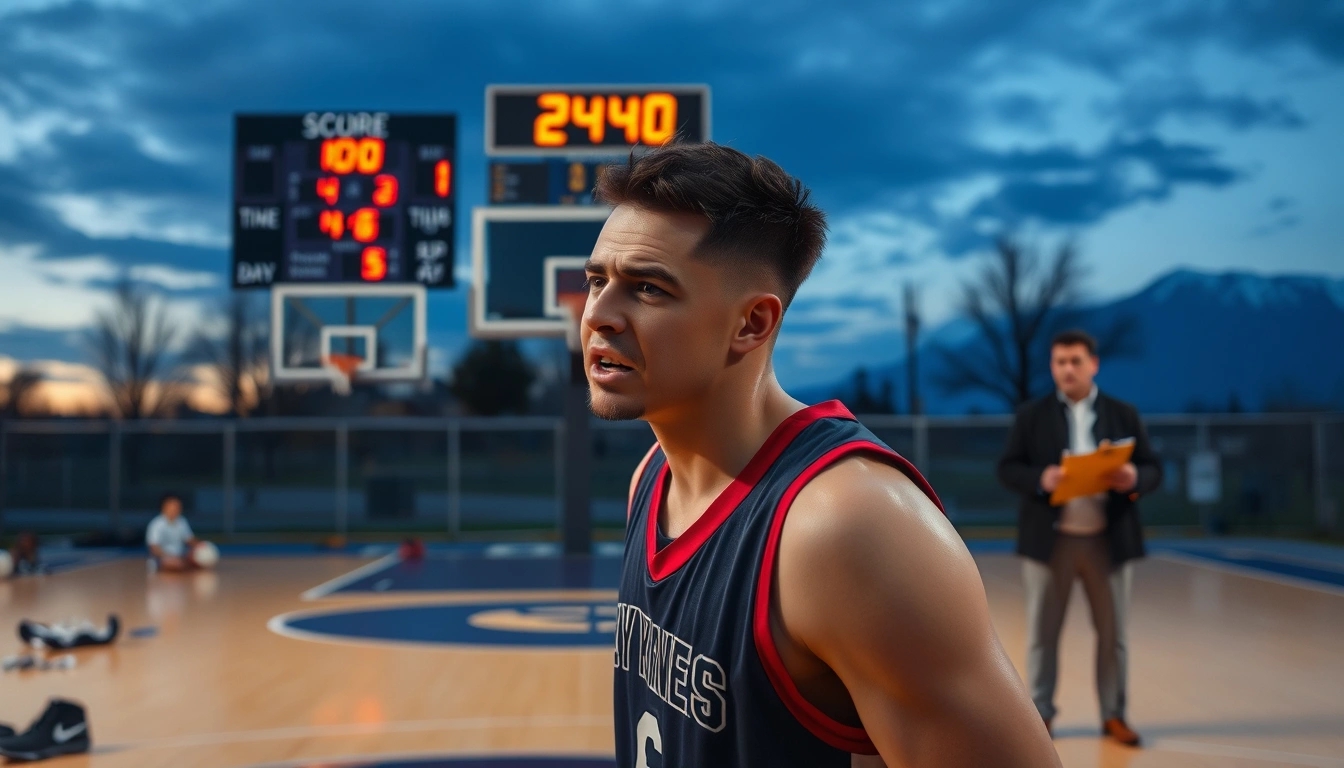Look, mistakes happen — especially in sports. If you think pros never screw up, you’re living in a fantasy world. The truth? Everyone flubs a play, misses an easy shot, or just plain tanks at some point. The real question is: how do you handle it when it all goes sideways? This isn’t some fluffy pep talk. We’re talking real strategies and straight-up advice to face those slip-ups head-on and come out swinging stronger than ever.
First off, understanding why mistakes happen is crucial. It’s not just about being “bad” or “off your game.” Sometimes it’s nerves, sometimes it’s fatigue, or just plain bad luck. When you realize mistakes are just part of the deal, it’s easier to keep your cool and not spiral into a pity party.
| Common Causes of Mistakes | What to Do About It |
|---|---|
| Fatigue or lack of focus | Prioritize rest and mental breaks |
| Pressure and anxiety | Practice mindfulness and breathing exercises |
| Poor technique or preparation | Review fundamentals and train smarter |
| External distractions | Develop routines to block out noise |
Now, let’s not sugarcoat it — messing up can mess with your head. That mental toll? It’s real. You might find yourself replaying the mistake on loop, beating yourself up like a broken record. The trick is to snap out of it. Positive self-talk isn’t just some cliché; it’s a game-changer. Visualizing success, telling yourself “I’ve got this,” or even laughing off a blunder can flip your mindset fast.
- Visualize your next success: Picture making that perfect shot or play.
- Talk yourself up: Replace “I messed up” with “I’m learning and getting better.”
- Focus on what you can control: Like your effort and attitude, not the scoreboard.
Another lifesaver? Building a solid support system. Nobody wins alone. Coaches, teammates, friends, even family — they’re your safety net. When you’re down, lean on them. They’ll remind you of your strengths when your brain’s busy doubting everything.
Here’s a quick rundown of strategies to bounce back quickly:
1. Acknowledge the mistake without drama.2. Analyze what went wrong - no finger-pointing.3. Set a small, achievable goal to regain confidence.4. Use relaxation techniques to reset mentally.5. Get back in the game ASAP - don’t dwell too long.
Look at it this way: every mistake is a chance to learn. Instead of letting errors define you, let them refine you. Study what happened, adjust your game plan, and keep grinding. And if you need inspiration, just remember all those legendary athletes who bombed big but came back bigger. Their stories aren’t just feel-good fluff — they’re proof that mistakes don’t have the final say.
Finally, if you’re a coach or trainer, your role is huge. Creating an environment where mistakes aren’t the end of the world but a stepping stone to growth is key. Encourage your players to embrace imperfection, foster resilience, and celebrate progress, not just perfection.
So yeah, screw-ups suck. But they’re also part of the beautiful chaos that makes sports so thrilling. Own your mistakes, learn from them, and bounce back like a champ.
Understanding the Nature of Mistakes
Let’s get real for a second: mistakes are as inevitable in sports as sweat and sore muscles. Whether you’re a rookie fumbling your first pass or a seasoned pro missing a crucial shot, errors happen. And no, it’s not just because you’re “off your game” or had a bad breakfast. There’s a whole cocktail of reasons behind those slip-ups, and figuring out why they happen is half the battle won.
First off, mistakes aren’t always about lack of skill or effort. Sometimes, it’s just plain human nature kicking in. Pressure, distractions, fatigue, or even overthinking can trip you up. Ever noticed how the simplest plays get complicated when the crowd’s roaring or the scoreboard’s ticking down? That’s your brain trying to juggle too many balls at once — and dropping one or two.
- Pressure overload: When the stakes are high, your mind can freeze or rush, leading to sloppy decisions.
- Fatigue factor: Physical and mental tiredness dull your reflexes and focus.
- Overconfidence: Sometimes, thinking you’ve got it in the bag makes you careless.
- External distractions: Noise, weather, or even a heckler can throw you off balance.
Now, here’s a little table to break down common mistake triggers and their sneaky effects:
| Trigger | Effect on Performance | Typical Scenario |
|---|---|---|
| Pressure | Paralysis or rushed moves | Last-minute penalty kick |
| Fatigue | Slower reaction times | Fourth quarter in a basketball game |
| Overconfidence | Ignoring basics | Easy pass turned into a turnover |
| Distractions | Loss of focus | Annoying crowd noise during free throws |
Here’s the kicker: understanding these causes isn’t about making excuses. It’s about getting smart with how you respond. If you know that your brain tends to freeze under pressure, you can train yourself to breathe, refocus, or have a go-to routine to snap out of it. If fatigue’s your nemesis, maybe it’s time to rethink your conditioning or recovery.
And don’t get me started on the mental traps! Sometimes, the mistake itself isn’t the problem — it’s the spiral of negativity that follows. Beating yourself up or dwelling on what went wrong just drags you down further. Instead, recognizing that mistakes are part of the process helps you keep your cool and stay in the game mentally.
Mistake Happens --> Recognize Cause --> Accept & Learn --> Adjust Approach --> Move Forward
In the end, mistakes are less about failure and more about feedback. They’re like those annoying coaches yelling from the sidelines, telling you what not to do next time. So, instead of freaking out, try to see errors as your personal playbook for growth. Because, honestly, if you never messed up, you probably weren’t pushing hard enough.
So next time you trip up, remember: it’s not the end of the world. It’s just part of the game. And the sooner you get that, the sooner you can bounce back smarter, tougher, and ready to take on whatever comes next.
The Psychological Impact of Errors
Let’s be honest here: messing up isn’t just about the scoreboard ticking down or the crowd groaning. It’s a full-on mind game that can throw even the toughest athletes into a tailspin. When you screw up, it’s not just the mistake itself that stings—it’s the mental chaos that follows. Suddenly, your confidence takes a nosedive, your focus scatters like leaves in the wind, and that nagging voice in your head starts playing the worst hits on repeat. “Why’d I do that? I’m such an idiot!” Sound familiar? Yeah, it’s a brutal loop.
Mistakes have this sneaky way of messing with your headspace, and if you don’t catch it early, it can snowball. Anxiety creeps in, self-doubt settles down like an unwanted houseguest, and before you know it, you’re stuck in a mental rut. And guess what? This isn’t just about feeling bad—it actually affects your performance. The brain’s wired to replay errors, making it harder to focus on the next move. It’s like trying to sprint while dragging a heavy chain behind you.
| Psychological Effects of Mistakes | How It Manifests | Possible Consequences |
|---|---|---|
| Loss of Confidence | Second-guessing every decision | Reduced risk-taking, hesitation |
| Anxiety & Stress | Racing heart, sweaty palms | Impaired focus, poor decision-making |
| Negative Self-Talk | Internal criticism and blame | Lower motivation, burnout |
Now, don’t get me wrong—everyone messes up. Even the greats have their “oops” moments. But the key difference? How you handle that mental fallout. Some athletes let it eat them alive, spiraling into a mess of frustration and blame. Others? They learn to hit the mental reset button, shake off the dust, and get back in the game with a clearer head.
- Recognize the mistake for what it is: a moment in time, not your identity.
- Practice self-compassion: cut yourself some slack instead of beating yourself up.
- Refocus on the present: the next play, the next move, the next chance to shine.
One trick that’s surprisingly underrated is simply breathing. Sounds lame? Maybe, but deep, controlled breaths can calm that racing mind and bring you back from the edge of a meltdown. It’s a tiny pause with huge payoff.
And hey, if your head’s still spinning, don’t hesitate to lean on your team or coach. Talking it out can clear the fog and remind you you’re not alone in this mess.
Quick Mental Reset Tips:- Take 3 deep breaths (inhale for 4, hold for 4, exhale for 6)- Repeat a positive mantra (“I’ve got this” or “Next play, next chance”)- Visualize a successful next move- Shake off tension with a quick physical movement (jump, shake hands)
In the end, mistakes are part of the game, but their psychological impact doesn’t have to be a career killer. It’s all about how you manage the mental aftermath. Because if you let errors define you, well, you’re already losing before the whistle blows.

Common Mistakes Athletes Make
Let’s be honest — in sports, messing up is as inevitable as the sun rising. From that cringe-worthy missed shot right when the crowd’s holding its breath, to those baffling bad calls that make you question if the ref’s got their glasses on, athletes stumble in ways that are almost too predictable. But here’s the kicker: recognizing these slip-ups isn’t about beating yourself up; it’s about gearing up smarter for the next round.
- Overthinking in the Heat of the Moment: Ever seen a player freeze, staring at the ball like it’s some alien artifact? Happens more than you think. When adrenaline spikes, the brain sometimes decides to take a coffee break, leaving the body confused. This mental overload leads to hesitation or rushed moves, which usually end badly.
- Ignoring Fundamentals: Fancy footwork and flashy plays are great for highlight reels, but forgetting the basics? Rookie mistake. Sloppy passes, poor positioning, and weak defense often trace back to neglecting core skills during practice.
- Letting Frustration Take the Wheel: We all get ticked off when things go south — but letting anger dictate your next move? Recipe for disaster. A single bad call or a missed opportunity can spiral into multiple errors if emotions aren’t kept in check.
| Mistake | Why It Happens | How to Fix It |
|---|---|---|
| Missed Shots | Pressure, poor focus, or fatigue | Practice under simulated pressure, improve stamina, and focus drills |
| Bad Calls | Miscommunication or lack of awareness | Enhance team communication, study game scenarios |
| Turnovers | Rushed decisions, poor ball handling | Slow down play, sharpen technical skills |
Now, don’t get me wrong — it’s not just about physical errors. Sometimes the biggest blunder is how athletes deal with those errors. Ever noticed how some players seem to spiral after a single mistake, while others shrug it off like a mosquito bite? That’s the mental game right there.
Here’s a quick rundown of some other classic goofs that trip athletes up repeatedly:
- Playing Too Safe: Fear of messing up can lead to timid play, which ironically increases the chance of mistakes.
- Ignoring Opponent’s Strengths: Underestimating the other team’s tactics or star players is a surefire way to get caught off guard.
- Poor Recovery Habits: Neglecting rest and recovery can cause fatigue-fueled errors to pile up.
Practical Insight: Keep a “Mistake Journal.” Jot down what went wrong, why, and what you’ll do differently next time. It sounds old school, but this simple habit turns mistakes into a roadmap for improvement.
At the end of the day, stumbling is part of the journey. The key isn’t to avoid mistakes altogether — that’s just wishful thinking — but to spot them early, learn fast, and bounce back harder. Because every athlete who’s ever made it big has a trail of blunders behind them. The difference? They didn’t let those mistakes write their story.
Strategies to Bounce Back Quickly
Recovery from a mistake isn’t just about nursing a bruised body or catching your breath. Nope, it’s a full-on mental game, too. When you flub a play, miss that shot, or just plain mess up, the clock’s ticking on how fast you can shake it off and get back in the groove. Dwelling on the slip-up? That’s a luxury you can’t afford in the heat of competition.
- First things first: recognize that mistakes are part of the journey. No one’s perfect—not the pros, not the rookies, nobody. Accepting this upfront reduces the pressure and keeps panic at bay.
- Next up: don’t stew in self-doubt. It’s tempting to spiral into a mental black hole, replaying the error like a broken record. But that’s a fast track to tanking your confidence.
| Common Mental Pitfalls | Quick Fixes |
|---|---|
| Overthinking the mistake | Focus on the next play, not the last one |
| Negative self-talk | Replace “I blew it” with “I’ll get it next time” |
| Fear of repeating errors | Visualize success, not failure |
Now, here’s a little secret that many overlook: mental reset techniques can be your best friend. Deep breaths, a quick walk, or even a funny joke with a teammate can snap you out of that funk. It’s like hitting the refresh button on your brain.
- Visualization: Picture yourself nailing that next move. It’s not woo-woo stuff; it’s science. Your brain can’t tell the difference between a real win and a vivid mental replay.
- Positive self-talk: Talk to yourself like you would a teammate who just messed up. Encouraging, not berating.
And don’t forget the power of your crew. Coaches, teammates, even family—they’re your safety net. When you’re down, a few words of encouragement or a pat on the back can do wonders. It’s not just about toughing it out solo.
"Hey, it happens to the best of us. Shake it off and show ’em what you’re made of!"
Lastly, remember that quick recovery isn’t about pretending the mistake never happened. It’s about acknowledging it, learning from it, and moving on fast enough so it doesn’t snowball. The clock’s always ticking, and your next chance to shine is just around the corner.
In short, bouncing back quickly is a mix of mental toughness, smart strategies, and leaning on your support system. Screw perfection—embrace the mess-ups and use them as fuel to get better, faster, and stronger. Because at the end of the day, it’s not the mistake that defines you, but how you respond to it.
Using Visualization and Positive Self-talk
Look, nobody’s perfect — especially when the pressure’s on and the crowd’s roaring. But here’s a little secret that some top athletes swear by: mental tricks. You know, those moments when you close your eyes and imagine nailing that winning shot or crossing the finish line first? That’s visualization in action, and it’s way more powerful than it sounds.
When you picture success — not just the outcome but the entire process — your brain starts wiring itself to believe it’s possible. It’s like rehearsing a play in your head before the curtain rises. The more vivid and detailed the mental image, the stronger the effect. You don’t just see yourself scoring; you feel the sweat, hear the crowd, and even taste the victory. Crazy, right? But that’s the magic of visualization.
- Visualize the process: Don’t just focus on the end goal. Picture every step, every move.
- Use all senses: Hear, see, feel, and even smell the environment to make it real.
- Practice regularly: Like muscles, your brain needs training too.
Now, let’s talk about positive self-talk. This one’s tricky because when you mess up, your inner voice can turn into a real jerk. “You blew it,” “You’re terrible,” blah blah blah. But here’s the catch — you can flip the script. Instead of letting that negativity run wild, try talking to yourself like you’d talk to a teammate who just messed up. Encouraging, supportive, and maybe a little sassy.
Think of it like this: your brain is the DJ, and you get to pick the tunes. Play the hype songs, not the sad ballads. Say stuff like:
“You got this next time.”“Everyone slips up, just shake it off.”“Focus on what you can control.”
It’s not about pretending everything is perfect, but about building a mindset that keeps you in the game.
| Common Negative Thoughts | Positive Self-talk Alternatives |
|---|---|
| “I always mess up.” | “Mistakes happen, I learn and improve.” |
| “I’m not good enough.” | “I’m working hard and getting better every day.” |
| “I’ll never recover from this.” | “One setback won’t stop me.” |
So yeah, mental tricks like visualization and positive self-talk aren’t just fluffy motivational mumbo jumbo. They’re tools that help flip the script from feeling like a failure to owning your confidence. And honestly, in the heat of competition, that mental edge can be the difference between folding and fighting back.
Remember: It’s not about being perfect — it’s about being persistent.
Building a Support System
Look, nobody’s an island — especially in sports. You might think you can tough it out solo, but trust me, leaning on others isn’t just a nice-to-have; it’s a game-changer. When you mess up — and you will, because hey, that’s life — having a crew behind you can soften the blow and speed up your bounce back. It’s like having a safety net that catches you before you hit rock bottom.
Why a support system matters:
- Emotional cushioning: When the pressure’s on and the mistakes pile up, having someone to vent to or get a pep talk from can keep your head in the game.
- Perspective check: Sometimes you’re too close to the mess to see clearly. Coaches, teammates, or family can offer fresh eyes and honest feedback.
- Accountability boost: It’s easier to stay motivated when you know people are counting on you and rooting for your comeback.
Think about it — even the legends had mentors and squads backing them up. Michael Jordan didn’t just practice shots by himself; he had coaches pushing him, teammates challenging him, and family supporting him through thick and thin. So why should you be any different?
| Support Source | Role | How They Help |
|---|---|---|
| Coaches | Guides and strategists | Provide technical feedback, mental coaching, and keep you focused on the bigger picture. |
| Teammates | Partners in crime | Offer camaraderie, share experiences, and help rebuild confidence after a slip. |
| Family & Friends | Emotional anchors | Give unconditional love, encouragement, and remind you who you are beyond the sport. |
Now, don’t get me wrong, building this network isn’t about being needy or complaining non-stop. It’s about creating a circle where honesty and support flow both ways. You gotta be willing to open up — awkward as that might feel — and accept help without feeling like you’re weak. Spoiler alert: leaning on others is a strength, not a crutch.
Here’s a quick checklist to build your own support squad:
- Identify people you trust and respect.
- Communicate openly about your struggles and goals.
- Be ready to listen and support them too — it’s a two-way street.
- Keep in touch regularly; don’t wait for a crisis to reach out.
And if you’re thinking, “Yeah, easier said than done,” you’re not alone. Opening up can be scary. But the payoff? Huge. When you have your people, mistakes don’t feel like the end of the world. They become just bumps on the road, with friends and mentors helping you steer back on track.
In the end, sports aren’t just about physical skill or talent — they’re about resilience, and resilience thrives in community. So next time you’re down after a blunder, remember: nobody wins alone. Reach out, lean in, and watch how your comeback story unfolds with a little help from your team.
Learning from Mistakes: Turning Errors into Growth
Look, nobody’s perfect — especially not in sports. You mess up; it’s just part of the game. But here’s the kicker: every single mistake you make isn’t just a fail, it’s a golden opportunity wrapped in frustration. Sounds cheesy? Maybe. But it’s true. The trick is learning how to analyze your errors without beating yourself up or throwing your gear across the room. Easier said than done, right? Let’s break it down.
First off, when you screw up, don’t just shrug it off or pretend it never happened. That’s like ignoring a flat tire and hoping you’ll magically roll faster. Instead, take a moment to reflect. Ask yourself: What exactly went wrong? Was it a lack of focus? Poor technique? Or maybe nerves got the best of you? Pinpointing the root cause is crucial. Without that, you’re just spinning your wheels.
- Step 1: Identify the mistake clearly.
- Step 2: Understand why it happened.
- Step 3: Think about what you can do differently next time.
Sounds simple, but it takes practice. And yeah, sometimes you’ll feel like your brain’s on vacation when you try to analyze your errors. That’s normal. Just keep at it.
Now, here’s a little secret: not all mistakes are created equal. Some are tiny blips, like missing an easy pass; others might be game-changers, like a costly foul. But both types carry lessons. To help you out, here’s a quick table showing how to approach different mistakes:
| Mistake Type | How to Analyze | Growth Opportunity |
|---|---|---|
| Technical Error | Review your form or strategy. | Improve skills through targeted practice. |
| Mental Lapse | Recognize distractions or pressure points. | Develop focus and mental toughness. |
| Communication Breakdown | Evaluate team interactions. | Enhance teamwork and clarity. |
Here’s the catch: learning from mistakes isn’t about obsessing over them. It’s about using them as stepping stones. Think of it like this — each error is a little nudge pushing you toward better decisions and sharper skills.
But don’t kid yourself — sometimes it’s downright hard to stay positive after a mess-up. You might want to scream, quit, or blame the referee (been there, done that). That’s why it’s vital to have a system in place for bouncing back. Whether it’s a pep talk from your coach, a quick mental reset, or just laughing off the blunder with teammates, find what works for you.
Practical Tips for Turning Mistakes into Growth:- Keep a mistake journal: Write down what happened and what you learned.- Watch game footage: Seeing your errors helps spot patterns.- Set small goals: Focus on improving one thing at a time.- Embrace feedback: Even if it stings, it’s gold for growth.
At the end of the day, mistakes don’t define you — your response does. So next time you trip up on the field or court, remember: it’s not the end of the world. It’s just a detour on the road to getting better, stronger, and smarter. Now go out there and make some mistakes worth learning from!

Real-Life Comeback Stories
Nothing gets the adrenaline pumping quite like hearing about athletes who hit rock bottom and then clawed their way back to the top. It’s like watching a slow-motion movie where the hero stumbles, falls flat on their face, but then rises with a fire that refuses to die out. These stories aren’t just feel-good fluff; they’re proof that mistakes aren’t the end of the line — they’re just the start of a new chapter.
Take, for example, the legendary basketball player who missed the game-winning shot in a championship final. The headlines tore him apart, fans questioned his grit, and the pressure? Oh, it was enough to make anyone crumble. But instead of hiding, he doubled down on training, rewired his mindset, and came back the next season with a vengeance — leading his team to victory and earning MVP honors. That’s not luck; that’s sheer grit and refusing to let one slip-up define your entire career.
| Athlete | Setback | Comeback Highlight |
|---|---|---|
| Serena Williams | Multiple injuries and health scares | Returned to win Grand Slam titles post-motherhood |
| Michael Jordan | Cut from high school basketball team | 6 NBA Championships and 5 MVP awards |
| Simone Biles | Withdrew from Olympic events due to mental health | Returned to win bronze and inspire millions |
What’s fascinating is that these athletes often share a few things in common beyond their talent: a stubborn refusal to quit, a support system that kept them grounded, and a way of reframing mistakes as lessons rather than failures. It’s not about pretending the mistake didn’t happen — it’s about acknowledging it, learning from it, and then moving forward with a sharper edge.
- Stubbornness: The “I’m not done yet” attitude.
- Support: Coaches, family, friends — the pit crew behind the star driver.
- Reflection: Breaking down what went wrong without drowning in regret.
And let’s be honest, the road back is rarely a straight line. Sometimes it’s messy, filled with setbacks that make you question everything. But that’s exactly what makes the comeback sweeter. It’s the human story of resilience, of battling your inner demons and the harsh voices that say you’re done.
So, if you’re an athlete staring at a mistake that feels like a mountain, remember these stories. Mistakes don’t define you — your response does. And sometimes, that response is a spectacular comeback that echoes far beyond the scoreboard.
In short: Everyone flops. Everyone screws up. But champions? They get back up, dust off the dirt, and show the world what they’re really made of.
Practical Tips for Coaches and Trainers
Let’s be honest, coaching ain’t just about drawing up plays or yelling from the sidelines. When athletes mess up — and trust me, they will — it’s the coach’s job to step in, keep cool, and turn that blunder into a stepping stone. Easier said than done, right? But here’s the deal: mistakes are gold mines for growth if you know how to dig. So, how do coaches actually do that without losing their minds or their team’s trust? Buckle up, here’s the real talk.
- Normalize Mistakes: First off, make it crystal clear that errors are part of the game. This isn’t just fluff — when athletes feel safe admitting screw-ups, they’re more likely to learn from them rather than hide or spiral into self-doubt.
- Focus on Effort, Not Just Outcome: Praise hustle and smart decisions, even if the scoreboard doesn’t reflect it. This shifts the mindset from “I failed” to “I’m improving.”
- Keep Feedback Specific and Constructive: Nobody wants a vague “you messed up.” Point out exactly what went wrong and how to fix it. Example? Instead of “bad pass,” say “next time, watch the defender’s angle before passing.”
Now, coaches, here’s a little cheat sheet for those tough moments when the team’s morale dips after a big mistake:
| Situation | Coach’s Approach | Goal |
|---|---|---|
| Player misses critical shot | Encourage quick reset, remind them of past successes | Prevent dwelling on failure, build confidence |
| Team commits repeated errors | Call a quick timeout, refocus energy with a positive pep talk | Regain composure and teamwork |
| New player struggles under pressure | One-on-one chat, share personal stories of mistakes | Build trust and reduce anxiety |
Here’s a little secret: empathy is your best tool. If you sound like a broken record or a robot spitting out corrections, good luck keeping your team’s ears open. Instead, get real. Share your own screw-ups from back in the day (we all have those cringe moments). It makes you human, relatable, and shows that perfection is a myth.
- Encourage a Growth Mindset: Teach your athletes that skills aren’t fixed; they can always get better. This mindset flips mistakes from being disasters into opportunities.
- Use Visualization Techniques: Help players imagine themselves succeeding after a mistake. Sounds woo-woo, but it’s backed by science.
- Build a Supportive Team Culture: Make sure teammates are lifting each other up, not tearing down. Peer support can be just as powerful as coaching.
Finally, remember this: patience is key. Some athletes bounce back immediately, others need time. Don’t rush the process or expect instant magic. Your job is to be the steady hand guiding them through the storm, not the drill sergeant barking orders.
In short, coaching through mistakes is less about fixing errors and more about nurturing resilience. When your athletes know you’ve got their back, they’ll be more willing to take risks, learn from slip-ups, and come back swinging — every single time.
So, next time your star player flubs that game-winning shot, take a deep breath, drop the frustration, and remember: mistakes aren’t the end of the world — they’re just the start of the comeback story.
Frequently Asked Questions
- Why do athletes make mistakes even after training hard?
Great question! Mistakes happen because sports are dynamic and unpredictable—kind of like trying to juggle flaming torches while riding a unicycle. No matter how much you train, factors like pressure, fatigue, or split-second decisions can lead to errors. The key is understanding that mistakes are part of the process, not a sign of failure.
- How can I stop a mistake from ruining my entire game?
It’s easier said than done, but the trick is to reset your mindset quickly. Think of your brain as a GPS—if you take a wrong turn, it recalculates and finds a new route. Use positive self-talk and visualization to shift focus away from the error and back to your strengths. This mental reset helps you stay sharp and bounce back fast.
- What role does a support system play in overcoming mistakes?
Imagine trying to climb a mountain alone; it’s tough and lonely. Having coaches, teammates, or family cheering you on acts like a safety rope, catching you when you slip. They provide encouragement, perspective, and advice that can turn a stumble into a stepping stone for growth.
- Can analyzing my mistakes actually improve my performance?
Absolutely! Think of mistakes as clues in a detective story. By breaking down what went wrong, you uncover patterns and areas to improve. This constructive analysis transforms errors from setbacks into powerful lessons that sharpen your skills over time.
- What are some quick strategies to mentally bounce back after a mistake?
Try these simple tactics: take a deep breath, remind yourself that one mistake doesn’t define you, and visualize your next successful move. These quick mental shifts act like a reboot button, helping you regain confidence and focus instantly.
- How can coaches help athletes deal with mistakes effectively?
Coaches can create a culture where mistakes are seen as learning opportunities, not punishments. Offering constructive feedback, encouraging open communication, and modeling resilience helps athletes develop a growth mindset that thrives on challenges rather than fearing failure.
- Are there famous athletes known for bouncing back from big mistakes?
Definitely! Many top athletes have turned epic blunders into legendary comebacks—think of it like a phoenix rising from the ashes. Their stories remind us that mistakes don’t define your journey; how you respond to them does.












